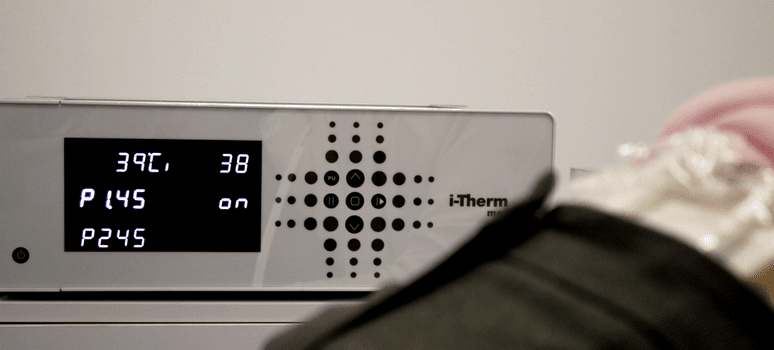
Body hyperthermia is a therapeutic technique that consists of artificially increasing body temperature. This technology is a great ally in complementary cancer treatments as it multiplies the probability of success.
For years the hyperthermia technique has been successfully supporting different types of medical treatments. In the case of oncological treatments, numerous studies and experience support the efficacy of This complementary technique, which, in the case of cancer, works in two ways:
- the increased temperature allows more of the chemotherapy substances to reach the cancer cells via the bloodstream.
- at the same time, it helps the body to eliminate the toxicity of the chemotherapy itself.
Depending on the instrumentation used, the hyperthermia method can be more or less effective and invasive for the patient, due to the greater or lesser heat sensation. At Biosalud Day Hospital we offer two types of hyperthermiaBoth are state-of-the-art: a total body hyperthermia bed, and the newly acquired i-wave molecular hyperthermia.
Molecular hyperthermia is applied to the skin with pads, and the type of energy it emits causes the area to heat up in depth, internally and in a focused way, increasing blood flow without the sensation of heat. This system can safely maintain a temperature range between 39º to 44ºC.
The The main therapeutic effect of hyperthermia is vasodilatation.as the local tissue heats up, the blood flow triggers two effects:
- promotes more efficient transport of oxygen and nutrients.
- Increases the evacuation of toxins and cellular waste from tissues that are heated.
How does hyperthermia improve the effect of chemotherapy?
The creator of the i-wave hyperthermia model, Professor Gerard Aknine, explains colloquially that, in the standard protocol, the chance of chemotherapy entering a tumour is like hitting the lottery because, after 24 hours, 90 per cent of what has been injected into the patient is lost. Studies that analyse the results of hyperthermia treatments confirm these figures, for example, in colon cancer, the response is positive in 7% of cases, but combining chemotherapy with hyperthermia, we have success in 92% of treatments. The expert adds that, in any case, check-ups after cancer treatment should be regular.

At Biosalud Day Hospital we have this technology, which should always be used in addition to the treatment prescribed by the oncologist. and with their knowledge. We work hand in hand to evaluate results and check the evolution of the treatment in each case.
In Spain, for example, the breast cancer is the most prevalent among women, with around 26,000 cases diagnosed each year. Its treatment combined with hyperthermia has success in 66% of the cases, compared to 42% when conventional treatment is applied without hyperthermia (EL Jones et al., 2005). In the prostate cancerIn the case of the combination of chemotherapy and hyperthermia, survival after three years of treatment reaches 97% in cases where chemotherapy is combined with hyperthermia, compared to 67% without hyperthermia (Strotsky et al., 1991).
The immune system, which is our protects against diseasedoes not distinguish between cancer cells and t-cells, so when it acts, it attacks them all equally. However, cancer cells are very sensitive to heat because they develop between veins and vessels through which they receive blood and glucose that favour their development, explains Gerard Aknini. This is one of the reasons why hyperthermia is effective in cancer treatments.
The protocols for the implementation of the molecular hyperthermia in cancer casesThe patients will be followed up to monitor their progress. In fact, the onset of cell response is detected two weeks after the start of treatment, when tumour necrosis and apoptosis, or cell suicide, can be observed.


1 thought on “Calor para combatir el cáncer”
Could someone please explain/clarify this paragraph?
"The immune system, which protects us from disease, doesn't distinguish between cancer cells and t-cells, so when it acts, it attacks all of them equally.
That description seems more in line with radio or chemotherapy. I could interpret it as "the tumour microenvironment could cause the immune system to...".
Otherwise, this sentence assumes that the immune system attacks its own cells. You are talking about autoimmune (pathological) reactions, which would be incorrect.
Comments are closed.